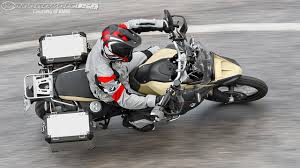
 2014 BMW F 800 GS Adventure Test
2014 BMW F 800 GS Adventure Test
Based on the
existing BMW F 800 GS platform, the new 2014 Adventure edition turns the
pavement-oriented base model into a true Gelände/Straße.
Key
changes include a larger under-seat gas tank (now over six gallons), a
strengthened sub-frame to accommodate the weight of additional fuel, a
wider bench-style seat, engine guards, robust hand protectors, larger
footpegs, a tall windscreen, and aluminum pannier frames that double as
fuel tank guards.
Options include Electronic Suspension Adjustment
(ESA) and Automatic Stability Control (ASC), and Enduro mode for the
motor—all of which I availed myself.
Staging out of the Sorrell
River Ranch, a luxury resort and spa in Utah on the Colorado River
outside of Moab, I have quick access to adventure motorcycle riding and
other off-road demands. The area hosts a mix of dirt and paved roads in
different maintenance conditions, giving me plenty of opportunities to
challenge the new 800.
As I had some tougher off-roading and
adventure in mind, I also had the F 800 GS Adventure equipped with an
aluminum skid plate (highly recommended for off-road) and BMW’s
Navigator GPS system, which conveniently mounts just below eye level on
the windscreen.
In the morning, the fuel-injected engine easily
fires up, and the various status symbols indicate that ABS and ASC are
active, as well as alerting me to the suspension setting. Utah State
High- way 128 is at the end of the Sorrel River Ranch driveway, so I
have the suspension set in the Comfort mode.
Heading north on
well-maintained pavement, the F 800 quickly and effortlessly accelerates
to highway speeds, and the tall windscreen protects well. My first
turn, Onion Creek Road — a wide hard-pack dirt road that rolls through
the valley floor with numerous creek crossings — comes up in just three
miles. This prompts me to toggle the ride setting from Road to Enduro
mode, which calibrates the ASC and ABS to work in the dirt.
Due to
the 800 Adventure’s seemingly light weight – it actually hits the
scales at a hair over 500 pound with a full tank of fuel — I feel like I
am riding my 200-plus pound dirt bike, happily cruising through the
shallow stream crossings without any concern about the bike’s suspension
ability to handle the challenges. After the stretch of hard-packed
surface and creek crossings, I encounter rather deep, powdered soil that
was more difficult than I anticipated. In this condition, the 800’s
weight distribution helped but the lack of low-end torque from the
parallel twin had me working the clutch like I was riding a two-stroke.
Once
free of the powder, my route takes me on a mix of hard pack dirt and
pavement roads that will lead me across the Utah-Colorado border via
Gateway Road. There, I find the bike’s cornering ability to be severely
limited on the non-paved surfaces; the front-end wants to push through a
corner when I attempt to carry a moderate amount of speed into a turn.
This
reluctance to turn causes further problems on the hard pack road that
winds down into Gateway Canyon, a treacherous route due to the
near-concrete surface having a thin overlay of sand. Fortunately, my
cautious riding helps me negotiate the downhill road. Happily, I make it
to Colorado State Highway 141 without incident.
After lunch at
Gateway Canyons, a luxurious resort and spa, I continue my ride in a
southerly direction on a fun, curve-filled section of Highway 141. In
this stretch, even with Continental tires that are oriented towards
off-pavement use, the F 800 GS Adventure feels more like a sport-tourer
than the large dual-sport motorcycle it is.
A fast 35 miles fly by
and I turn off the highway again, this time onto a dirt road
paralleling Dolores Creek. It’s a fairly straight, maintained hard pack
road used primarily by Jeeps and pickup trucks. In this stretch the
bike’s suspension, tuned to Comfort level, easily absorbs expanses of
washboard surfaces.
The road takes me to Colorado State Highway
90, where I head west, and rapidly open the throttle up and shift up to
sixth gear. Even though there is a bit of a crosswind, the well-designed
windshield never buffets or induces excessive movement. Highway 90
throws some fairly intense uphill switchback curves at me, yet the F 800
GS Adventure’s handling never feels compromised in the corners.
After
about 25 miles, I turn off Highway 90 and back onto dirt for a ride to
Geyser Pass (elevation: 10,528 feet). As the elevation increases, I
notice the engine’s power flagging a bit, as the EFI adapts to the
thinning oxygen. Still, the DOHC 798cc motor maintains adequate pull all
the way to the top.
On the descent, I find myself on a broad,
gravel road with sweeping turns. Again, I have to deal with the bike’s
lack of non-pavement cornering ability that limits my efforts to quickly
traverse unpaved roads. As before, I am able to keep it on two-wheels,
though it requires more skill and attention than it should.
Back
on the pavement — a mix of shredded and newly paved sections — I am
impressed by the 800’s ability to manage these variations at speed. I
continue northwest to connect with La Sal Mountain Loop, and then turn
north on to Utah State Highway 128 back to Sorrell River Ranch for a
well-deserved shower, dinner, and sleep. My first introduction to BMW’s
latest Adventure is a success.
The 2014 BMW F 800 GS Adventure has
the capability to go anywhere an adventure motorcyclist wants to go.
Although optional, features such as ESA and ASC feel mandatory. BMW has
taken the standard 800 GS and turned it into a bike that, with its range
extended 100 miles, is a bit more of a competitor for its 1200cc
brother. One-up adventurers will especially take note, I anticipate.










